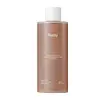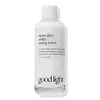What's inside
What's inside
 Key Ingredients
Key Ingredients

 Benefits
Benefits

 Concerns
Concerns

 Ingredients Side-by-side
Ingredients Side-by-side

Water
Skin ConditioningLactobacillus Ferment
Skin ConditioningButylene Glycol
HumectantIsopentyldiol
Humectant1,2-Hexanediol
Skin ConditioningDipropylene Glycol
HumectantOpuntia Ficus-Indica Stem Extract
Skin ConditioningPolyglyceryl-10 Laurate
Skin ConditioningBetaine
HumectantOpuntia Ficus-Indica Flower Extract
Skin ConditioningArginine
MaskingCarbomer
Emulsion StabilisingEthylhexylglycerin
Skin ConditioningAdenosine
Skin ConditioningHydrolyzed Sclerotium Gum
HumectantHydrolyzed Jojoba Esters
Skin ConditioningTheobroma Cacao Seed Extract
AntioxidantSodium Phytate
Parfum
MaskingAllantoin
Skin ConditioningSodium Citrate
BufferingCitric Acid
BufferingCaffeine
Skin ConditioningPanthenol
Skin ConditioningBacillus Ferment
Skin ConditioningGlycerin
HumectantTocopherol
AntioxidantOpuntia Ficus-Indica Seed Oil
EmollientCeramide NP
Skin ConditioningPhytosphingosine
Skin ConditioningHydrogenated Lecithin
EmulsifyingBenzyl Salicylate
PerfumingHexyl Cinnamal
PerfumingWater, Lactobacillus Ferment, Butylene Glycol, Isopentyldiol, 1,2-Hexanediol, Dipropylene Glycol, Opuntia Ficus-Indica Stem Extract, Polyglyceryl-10 Laurate, Betaine, Opuntia Ficus-Indica Flower Extract, Arginine, Carbomer, Ethylhexylglycerin, Adenosine, Hydrolyzed Sclerotium Gum, Hydrolyzed Jojoba Esters, Theobroma Cacao Seed Extract, Sodium Phytate, Parfum, Allantoin, Sodium Citrate, Citric Acid, Caffeine, Panthenol, Bacillus Ferment, Glycerin, Tocopherol, Opuntia Ficus-Indica Seed Oil, Ceramide NP, Phytosphingosine, Hydrogenated Lecithin, Benzyl Salicylate, Hexyl Cinnamal
Water
Skin ConditioningGlycerin
HumectantLimnanthes Alba Seed Oil
Skin ConditioningCeramide NP
Skin ConditioningTremella Fuciformis Sporocarp Extract
AntioxidantNiacinamide
SmoothingSodium Hyaluronate
HumectantPanthenol
Skin ConditioningUrea
BufferingAllantoin
Skin ConditioningTocopherol
AntioxidantAvena Sativa Kernel Extract
AbrasivePelargonium Graveolens Flower Oil
MaskingRose Flower Oil
MaskingCitrus Aurantifolia Fruit Extract
Skin ConditioningHovenia Dulcis Fruit Extract
Skin ConditioningCitrus Limon Fruit Extract
MaskingCocos Nucifera Fruit Extract
EmollientOpuntia Ficus-Indica Fruit Extract
Skin ConditioningPyrus Malus Fruit Extract
Skin ConditioningPhenoxyethanol
PreservativePropanediol
SolventArgania Spinosa Kernel Oil
EmollientCanola Oil
EmollientHelianthus Annuus Seedcake
AbrasiveSodium Lactate
BufferingPolyglyceryl-10 Stearate
Skin ConditioningCarbomer
Emulsion StabilisingPentylene Glycol
Skin ConditioningXylitylglucoside
HumectantArginine
MaskingAnhydroxylitol
HumectantXylitol
HumectantCeramide AP
Skin Conditioning1,2-Hexanediol
Skin ConditioningMyrtus Communis Oil
MaskingFerula Galbaniflua Resin Oil
AntimicrobialThuja Occidentalis Leaf Extract
AntioxidantVanilla Planifolia Fruit Extract
Skin ConditioningRosa Canina Fruit Oil
EmollientCitrus Aurantium Bergamia Fruit Oil
MaskingOlea Europaea Fruit Oil
MaskingJasminum Officinale Oil
MaskingCitrus Grandis Peel Oil
MaskingPersea Gratissima Oil
Skin ConditioningCedrus Atlantica Bark Oil
MaskingLavandula Angustifolia Oil
MaskingEthylhexylglycerin
Skin ConditioningDisodium EDTA
Water, Glycerin, Limnanthes Alba Seed Oil, Ceramide NP, Tremella Fuciformis Sporocarp Extract, Niacinamide, Sodium Hyaluronate, Panthenol, Urea, Allantoin, Tocopherol, Avena Sativa Kernel Extract, Pelargonium Graveolens Flower Oil, Rose Flower Oil, Citrus Aurantifolia Fruit Extract, Hovenia Dulcis Fruit Extract, Citrus Limon Fruit Extract, Cocos Nucifera Fruit Extract, Opuntia Ficus-Indica Fruit Extract, Pyrus Malus Fruit Extract, Phenoxyethanol, Propanediol, Argania Spinosa Kernel Oil, Canola Oil, Helianthus Annuus Seedcake, Sodium Lactate, Polyglyceryl-10 Stearate, Carbomer, Pentylene Glycol, Xylitylglucoside, Arginine, Anhydroxylitol, Xylitol, Ceramide AP, 1,2-Hexanediol, Myrtus Communis Oil, Ferula Galbaniflua Resin Oil, Thuja Occidentalis Leaf Extract, Vanilla Planifolia Fruit Extract, Rosa Canina Fruit Oil, Citrus Aurantium Bergamia Fruit Oil, Olea Europaea Fruit Oil, Jasminum Officinale Oil, Citrus Grandis Peel Oil, Persea Gratissima Oil, Cedrus Atlantica Bark Oil, Lavandula Angustifolia Oil, Ethylhexylglycerin, Disodium EDTA
Ingredients Explained
These ingredients are found in both products.
Ingredients higher up in an ingredient list are typically present in a larger amount.
1,2-Hexanediol is a synthetic liquid and another multi-functional powerhouse.
It is a:
- Humectant, drawing moisture into the skin
- Emollient, helping to soften skin
- Solvent, dispersing and stabilizing formulas
- Preservative booster, enhancing the antimicrobial activity of other preservatives
Allantoin is a soothing ingredient known for its protective and moisturizingg properties. Because of this, it is often added to products with strong active ingredients.
Studies show higher concentrations of this ingredient can promote wound healing.
Though it can be derived from the comfrey plant, allantoin is produced synthetically for cosmetic products to ensure purity.
Learn more about AllantoinArginine is an amino acid that is important for human development. Your body uses is it to produce hair keratin and skin collagen.
As a cosmetic ingredient, Arginine has antioxidant properties and can also help repair damaged skin. This ingredient is derived either synthetically or from animals.
Arginine isn't fungal acne safe when used in the presence of other lipids (fats, fatty acids, oils, esters, etc). Oils and fats occur naturally within the skin, so take caution when using Arginine if you're prone to fungal acne.
Learn more about ArginineCarbomer is a polymer of acrylic acid. Its main role is to create a gel consistency.
A high amount of carbomer can cause pilling or balling up of products. Don't worry, most products contain 1% or less of carbomer.
Ceramide NP is a type of ceramide.
Ceramides are intercellular lipids naturally found in our skin that bonds dead skin cells together to create a barrier. They are known for their ability to hold water and thus are a great ingredient for dry skin.
Ceramides are an important building block for our skin barrier. A stronger barrier helps the skin look more firm and hydrated. By bolstering the skin ceramides act as a barrier against irritating ingredients. This can help with inflammation as well.
If you would like to eat ceramides, sweet potatoes contain a small amount.
Read more about other common types of ceramides here:
Ceramide AP
Ceramide EOP
Ethylhexylglycerin (we can't pronounce this either) is commonly used as a preservative and skin softener. It is derived from glyceryl.
You might see Ethylhexylglycerin often paired with other preservatives such as phenoxyethanol. Ethylhexylglycerin has been found to increase the effectiveness of these other preservatives.
Glycerin is already naturally found in your skin. It helps moisturize and protect your skin.
A study from 2016 found glycerin to be more effective as a humectant than AHAs and hyaluronic acid.
As a humectant, it helps the skin stay hydrated by pulling moisture to your skin. The low molecular weight of glycerin allows it to pull moisture into the deeper layers of your skin.
Hydrated skin improves your skin barrier; Your skin barrier helps protect against irritants and bacteria.
Glycerin has also been found to have antimicrobial and antiviral properties. Due to these properties, glycerin is often used in wound and burn treatments.
In cosmetics, glycerin is usually derived from plants such as soybean or palm. However, it can also be sourced from animals, such as tallow or animal fat.
This ingredient is organic, colorless, odorless, and non-toxic.
Glycerin is the name for this ingredient in American English. British English uses Glycerol/Glycerine.
Learn more about GlycerinPanthenol is a common ingredient that helps hydrate and soothe the skin. It is found naturally in our skin and hair.
There are two forms of panthenol: D and L.
D-panthenol is also known as dexpanthenol. Most cosmetics use dexpanthenol or a mixture of D and L-panthenol.
Panthenol is famous due to its ability to go deeper into the skin's layers. Using this ingredient has numerous pros (and no cons):
Like hyaluronic acid, panthenol is a humectant. Humectants are able to bind and hold large amounts of water to keep skin hydrated.
This ingredient works well for wound healing. It works by increasing tissue in the wound and helps close open wounds.
Once oxidized, panthenol converts to pantothenic acid. Panthothenic acid is found in all living cells.
This ingredient is also referred to as pro-vitamin B5.
Learn more about PanthenolTocopherol (also known as Vitamin E) is a common antioxidant used to help protect the skin from free-radicals and strengthen the skin barrier. It's also fat soluble - this means our skin is great at absorbing it.
Vitamin E also helps keep your natural skin lipids healthy. Your lipid skin barrier naturally consists of lipids, ceramides, and fatty acids. Vitamin E offers extra protection for your skin’s lipid barrier, keeping your skin healthy and nourished.
Another benefit is a bit of UV protection. Vitamin E helps reduce the damage caused by UVB rays. (It should not replace your sunscreen). Combining it with Vitamin C can decrease sunburned cells and hyperpigmentation after UV exposure.
You might have noticed Vitamin E + C often paired together. This is because it is great at stabilizing Vitamin C. Using the two together helps increase the effectiveness of both ingredients.
There are often claims that Vitamin E can reduce/prevent scarring, but these claims haven't been confirmed by scientific research.
Learn more about TocopherolWater. It's the most common cosmetic ingredient of all. You'll usually see it at the top of ingredient lists, meaning that it makes up the largest part of the product.
So why is it so popular? Water most often acts as a solvent - this means that it helps dissolve other ingredients into the formulation.
You'll also recognize water as that liquid we all need to stay alive. If you see this, drink a glass of water. Stay hydrated!
Learn more about Water